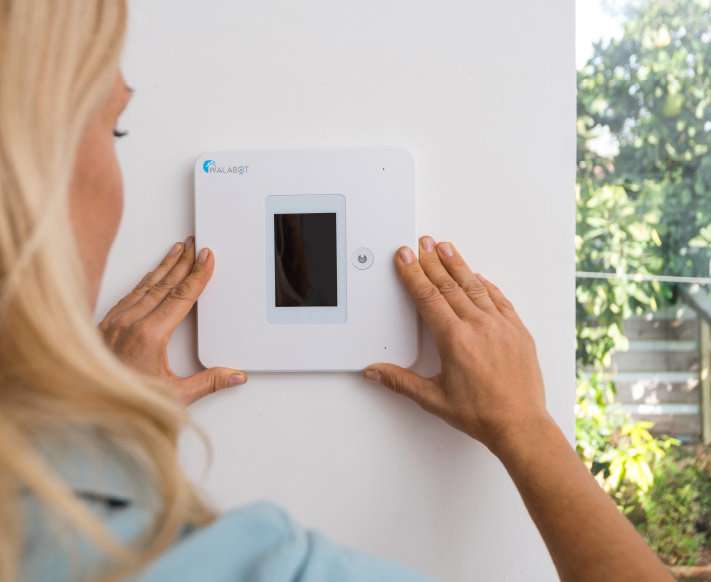October 26, 2018 weblog
Automatic fall detector attaches to wall, no wearable needed

For the elderly, falling down bears striking differences because, like sticks and stones, falls may well disturb some bones. Falls' outcomes may be a very far cry from a child's plaster on the knee, lollipop and note to the gym teacher. Falls can result in fractures, broken bones or injuries to the head, making it difficult to impossible for independent living.
Some bracing facts from the Centers for Disease Control and Prevention. "Each year, millions of older people—those 65 and older—fall. In fact, more than one out of four older people falls each year, but less than half tell their doctor." The CDC also said that falling once doubles chances of falling again.
A smarthome device in the news this month makes its debut as a detector of falls involving the elderly. The Walabot HOME is a small device that you install on your wall to detects falls. It automatically places a call for help to a contact of the person's choice. The company said a fall can be detected at a range of up to 10 feet in front of the device and within 5 feet on either side of the device.
The company behind Walabot is Vayyar, known for its sensor imaging technology. Actually, when it was founded in 2011, the effort focused on a modality for breast cancer detection by using RF to look into human tissue to detect malignant growths. The Vayyar technology evolved; the Vayyar team began to consider a wider application scope, including devices for the smart home.
Security Sales and Integration: According to the company, it was created to eliminate the need to carry a fall detection device by discreetly monitoring for a fall—it operates in the background of the home just like a smoke detector sensor.
In the bigger picture, the company is competing in a marketplace that, as anyone knows after reading site ads and seeing infomercials, has numerous "Personal emergency response systems (PERS)" systems to choose from if living with an elderly person or caring for an elderly person directly.
The difference is that this is not a wearable, whereas others are worn on the customer, such as pendants.
Matthew Greenwood in engineering.com spelled out the downside of wearables for fall detection: "Many personal emergency response systems rely on a 'panic button' device on a necklace or wristband, or installed on a smartphone, that the wearer can press if there is an accident. But those systems break down if the wearer is unconscious, in shock, is too injured to press the button or simply forgets to wear the device."
Raviv Melamed, CEO, Vayyar said his team have an answer for that. "People want to feel comfortable in their homes without the burden of needing to wear a pendant or medical alert device, but they still want the security of knowing that they can get help if they need it. Walabot HOME is so effective because people can set it up and then relax, feeling secure in the knowledge it's there just in case."
Another advantage offered by Vayyar's product is privacy. Detectors using cameras to monitor the elderly persons' movements may not satisfy their need for the comfort of privacy where falls may happen, such as bathrooms.
A third edge over camera-centric products is that Walabot HOME works in conditions that cameras cannot, including smoke, steam and darkness. This is where the company's expertise comes in; the device can sense through objects such as curtains and glass walls.
The device uses "advanced, low-power radio wave technology, similar to Wi-Fi."
Stepping you through what happens if a fall occurs, Vayyar called up two possible scenarios. In the first, "when a true fall occurs, the monitoring line on the screen of your Walabot HOME device will change from a fixed line to a moving wave, and the LED bulb will flash blue. Your device will then announce in a clear voice that a fall has been detected and that a phone call will be placed to your emergency contact."
With that call two-way voice communication is established through the Walabot HOME device itself.
In the second scenario, your Walabot HOME will function as described but you can cancel the alarm should no further action be necessary.
Medgadget said the device works with the Walabot HOME mobile app for iOS and Android. (The emergency contact designated during the installation process will need to download the Walabot HOME App to enable the two-way communication in the event of a fall.)
"It can monitor rooms up to 100 square feet—so it's clearly meant to be used in the bathroom or bedroom," wrote Senior Associate Editor CNET Andrew Gebhart. Given the small range, Gebhart said one may "need multiple sensors to cover a small apartment, which could get pretty costly." Nonetheless, he said, "the tech inside the Walabot is innovative."
If you visit the company site, you see that the home product is presented as something you hang in your bathroom. "Walabot HOME must be placed in the center of your bathroom in plain sight, at approximately eye-level, around 5 feet (1.5 meters) from the ground. It should not be hung near metal (shelving or otherwise). In order for the device to function, it needs an electrical outlet within reach and a WiFi connection in the bathroom."
Jon Fingas in Engadget remarked on the price and the product's range. The Walabot Home is available at $249, "and that might be the only real hurdle to adopting it. While that price isn't extreme by itself, complete around-the-house coverage could be expensive. Otherwise, you'll have to guess where you'd be most likely to slip and hope that you don't fall anywhere else."
© 2018 Science X Network


















